“Keeping many balls in the air”
Managing a multi-disciplinary veterinary and nutrition program in Kenya – an overview for May 2017
Blog by John VanLeeuwen and Jennifer Taylor (AKA Papa John and Mama Jen to the students!)
Our recent trip to Kenya in May was our busiest QES trip to Kenya ever, with many moving parts (many people going in different directions) and many projects on the go. One morning, we had 6 vehicles leaving from the Naari house with people involved in different parts of the overall Queen Elizabeth Scholar(QES)program. Most of our students are funded through the QES program, which provides support for six Kenyan students to attend UPEI to complete their Master’s (4 students) or PhD degrees (2students). After completing required coursework in Canada over the past two years, the Kenyan graduate students, along with two veterinary and two nutrition undergraduate UPEI students, travelled to Kenya in May 2017 to provide training and resources and to collect information necessary to complete their theses. It is important to note that their work complements the efforts of Farmers Helping Farmers (FHF) to improve milk production, food security and nutrition, and overall livelihoods of Kenyan farm families in Naari. We sometimes found it hard to keep the different projects straight while we were in Naari, so in this blog, we figured it would be good to describe the various projects and roles of people involved, to help the blog-readers with the big picture, and give a brief update on each.
1) Dennis Makau and Joan Muraya, Kenyan PhD students, continue monthly visits to train and conduct research on cow nutrition and cow reproduction on 100 dairy farms, respectively. With the drought that occurred last year and continued until March (good rains for the last 2 months), even farmers following recommended practices have run out of good quality stored feeds for their cows. However, the high-protein shrub seedlings that were distributed to farmers in early 2016 are doing well on most farms receiving them, helping to keep cattle protein intakes at a reasonable level. Milk collections at the Naari Dairy have remained at the 4000 L per day, despite the drought, and should go up substantially with the recent rains. Unfortunately, reproduction is the first thing to get hit with droughts, and it has suffered during the last year, with fewer cows showing heat, being bred, and conceiving, despite efforts to enhance uterine health and ovarian cycling. Again, breeding success should improve with the recent rains as body condition scores improve with better feeding. Monthly data collection and advice on improving nutrition and reproduction should quantify on-going costs and benefits of the training and resources provided.

2) Emily Kathambi, a Kenyan MSc student, initiated her training and research project on cow comfort on 100 dairy farms. Emily will be going to each farm 4 times. On the first visit, Emily gets baseline information on cow comfort, including stall design features and management, and attaching accelerometers to the cows’ legs for 3-5 days to get lying down times. On the second visit, she removes the accelerometers and gives specific oral and written advice on how to improve cow comfort with low cost changes in design and management. A month later, on the third visit, she will reassess stall design features and management and re -attach accelerometers. A few days later, on the final visit, she will remove the accelerometers and address stall changes left undone. One farmer started hammering some boards while we were washing our boots which was very gratifying and demonstrates the desire these farmers have to improve their farms.

3) Also a Kenyan MSc student, Sarah Muthee’s training and research project will be assessing the impact of a combined nutrition education and agriculture intervention on food security and diet diversity. The nutrition intervention involves teaching the women key nutrition messages regarding using whole grain maize for more nutrients, more beans to increase protein, and incorporating dark green and orange vegetables in to their githeri, a staple food(vegetable stew), among other messages. The agricultural interventions include water tanks and drip irrigation for home gardens, as well as horticulture support. Sarah is interviewing 29 women in the Upendo Women’s Group and will compare findings with those collected from the same women in 2016, which was within one month of the first teaching sessions. She will also assess differences between the Upendo Women’s group who received the combined intervention and a comparison group (n=20) which received no intervention. In both 2016 and 2017, the “Champs” programming (training the trainers) has been implemented to much fanfare and music – the women continue to amaze us with their welcoming nature and interest in improving nutrition for themselves and their families.

4) Grace Wanjohi (a Kenyan MEd student) has initiated a research project which builds on Sarah’s project: she will assess whether sending ‘booster’ nutrition messages via cell phon e to the women will increase their nutrition knowledge and make it more likely that they adopt recommendedpractices. TheUpendoWomen’sGroupwillreceivetheusualface-to-face intervention led by the women “champs” while the Joy Women’s Group (n=24) wi ll be sent two ‘reminder’ messages a week for 5 weeks . Grace will have completed her pre -intervention assessments by the end of May and will start sending booster text messages in June. Her post – intervention assessments will take place in July. If this i ntervention is successful, cell phone messaging could spread the training to large populations rather than just the small populations reached through in-person training.

5) Anne Shileche (a Kenyan MSc student) has a program evaluation project which aims to investigatetheimpactofthismulti-disciplinaryprojectonempowermentandcivicengagement among 3 groups of women within Naari: 1) from 20 dairy farms getting cow nutrition and reproduction training and resources (Dennis and Joan’s project); 2) from 20 farms belonging to members of the Upendo Women’s Group who are receiving both a human nutrition and agricultural intervention (Sarah and Grace’s project); and 3) from 20 farms not involved in any part of the project, as a control group. Anne has begun collecting information on the farms and will complete her data collection by the end of August. This research is important since it will document the non-veterinary/non-nutritional impacts of the project activities for women and whether they feel more empowered and confident to improve their homes, farms and communities. Anne is also interested in whether women extend this confidence and become moreinvolvedincivicengagementintheirneighbourhoodsandcommunities.
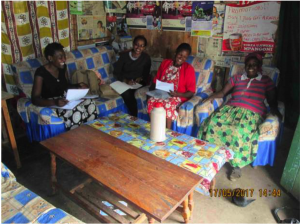
6) Julia Kenny and Ren Chamberlain, the 2017 veterinary interns, are helping with the veterinary projects above and they are also involved in a training and research project around silage. They are collecting information on farmers’ knowledge, attitudes, and practices around making and feeding silage. FHF has been promoting and facilitating silage -making so farmers have good quality feed even during the dry season, and in this part of Kenya, it is primarily corn silage. Very few farmers were actually feeding silage currently because of the light rains during the last year prior to March 2017 (having exhausted their silage stores), and because of the good rains now (so they have lots of fresh feed to give now). However, many farms now have some silage or are making silage for the up-coming dry season. Therefore, as the summer unfolds, the interns will be able to assess silage quality and on-going feeding practices. These interns will also be providing advice to these farmers on silage making and feeding, along with other health management recommendations appropriate for the farm.
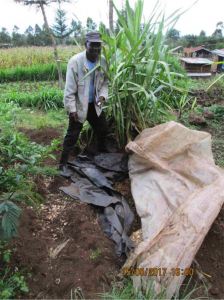
7) Mireyne MacMillan and Michaela Rowan, the 2017 nutrition interns, are working closely with Sarah and Grace on the nutrition projects above, as well as a number of other initiatives. They will tabulate information collected from all schools and will document the learnings from the “Champs” in terms of their experience, and how we can make things even more effective. They will also tabulate what the women do in terms of excess vegetables that are produced in the kitchen gardens (do they give it away or sell it to neighbours/a local market?). They w ill also assess whether women are growing the orange fleshy sweet potatoes which are being promoted by FHF for their good nutritional value (rich in vitamin A). The “M&Ms”, as we call them, will also be involved in assessing the quality of school meals for 9 Kenyan schools that are twinned with PEI schools. They will provide detailed feedback reports to schools in an effort to improvethenutritionalqualityofthemorningporridge(uji)andthelunchtimevegetablestew (githeri) for students, such as incorporating more vegetables from the new school gardens into these student meals so that they will have more vitamins and minerals to improve growth, reduce sickness and increase academic performance. For the first time this year, students will work with graduate students to deliver educational seminars to parents and teachers – often 100-200 at a time! These activities will keep them busy for their summer internships. The extended drought until March 2017 had an effect on the farm gardens and school gardens as well, but again, with the recent rains, there is optimism again that these gardens are improving. Regardless, Naari women are eager to learn and will apply this knowledge when the nutritious crops are available.
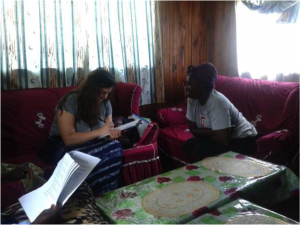
Just to make things a little more complicated, since clearly things are not complicated enough yet (sic), there were 7 more groups of people involved in the above projects in the past 3 weeks, either directly or indirectly.
-
A group of 3 student interns, sponsored by Vets without Borders-Canada(Alina Gardiner, Kelly Hammond and Megan White), worked with our project for the final week of the three weeks so that John could help with their in-country orientation. The three students, from Ontario, Saskatchewan and Alberta, learned about all aspects of our program and were introduced to Kenyan farming, culture, and life in Naari. They fit in very well with our Naari family, and some nights we had a baker’s dozen for dinner! John also traveled with them to Mukurwe-ini during his last couple of days in Kenya to introduce them to people at the Mukurwe -ini Wakulima Dairy Ltd. where they would be volunteering for the rest of the summer. John also introduced them to the Kenyan people who would be providing them with daily security, supervision and taxi services, and laundry and cooking services when needed. Dr. Shauna Richards has also provided them with orientation and will also be providing supervision during the summer.
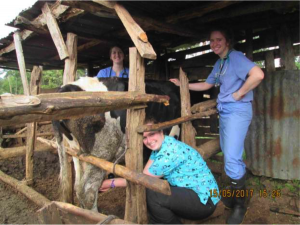
Kelly, Alina and Megan sampling a cow’s udder - A group of two professors, Drs. Lucy Kathuri and Joan Muriithi from Kenyatta University (KU), came to Naari for a 3 day trip to provide some direct supervision and input for their respective supervisory committee roles on their projects with Anne and Grace. Dr. Irene Ogada, working with Sarah, could not join them because she recently had a new baby. The timing of the trip was excellent because Lucy was able to help trouble -shoot Anne’s questionnaire one last time, and join Anne for her first two interviews, leading to some last minute wording changes that enhanced the understanding of the questions.
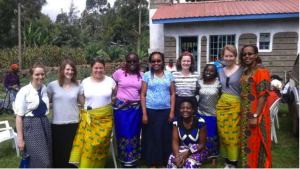
- Drs. George Gitau and Victor Tsuma, professors from Nairobi University and supervisory committee members, were unable to join us in Naari initially, but George will join the team in Naari in June when he has time. Fortunately, we met in Nairobi the day aft er landing in Kenya to discuss some logistics for the respective veterinary projects, which was helpful for fine-tuning plans for the upcoming weeks in Naari.
- FHF is one of the five official partners involved in the QES program, and they play an integral role in many of the program activities in the Naari area. Teresa and Ken Mellish (and other FHF people) were not in Kenya with us in the past 3 weeks but their input and suggestions from yearsof experienceinKenyawerefrequentlyutilizedbytheteam. StephenMwendaand Salome Ntinyari, Kenyan employees of FHF, were able to join the team in Naari for some farm and school visits, in addition to providing other valuable logistical support for local needs. Jennifer Murogocho, a dear friend of FHF, also prov ided immense logistical support to the team regarding security, housing, and transportation.
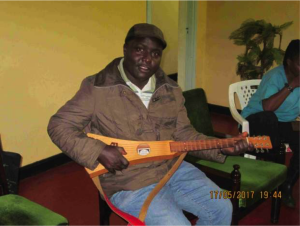
Photo: Stephen Mwenda (FHF staff) on guitar
- UPEI Supervisory committee members for the Kenyan graduate students also provided invaluable input in Canada in preparation for the Naari activities. Some of them have already been mentioned above; others include: Drs. Colleen Walton, Charlene VanLeeuwen, Carolyn Peach Brown, Shawn McKenna, Jeff Wichtel, Crawford Revie, Bronwyn Crane, Collins Kamunde, and Tim Goddard.
- Support personnel are sometimes forgotten, but we would like to acknowledge them here as well. The cooks, drivers and security guards make it possible for us to be well fed, productive, safe and secure while in Naari and Mukurwe -ini. And Henry Macharia, Susan and the excellent drivers at Sportsmens’ Safaris ensured that we had safe long distance transportation while in Kenya.
- Last, but certainly not least, the farmers, womens’ groups, and schools in the Naari area, along with the Naari Dairy Cooperative Society, have been nothing short of phenomenal in their partnership for the program activities. They have always been welcoming, helpful, and very hospitable. Special mention should go out to Geoffrey Imathiu (Chair of the Naari Dairy), Bernard Ndegwa (vet tech at Naari Dairy), and Mary Karimi Ndubi (Chair of the Upendo Women’s Group).
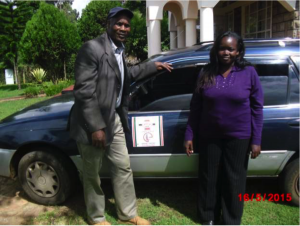
Photo: Geoffrey Imathiu with Leah Karioki (FHF staff)
We would like to thank all of these people (and anyone we may have forgotten) for making the first 3 weeks of the summer 2017 activities in Kenya very successful, and we hope that the momentum created by these three weeks continues throughout the summer.
